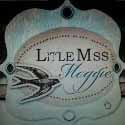First of all you need a laser copy. So select your image and if there is text, be sure to reverse your image (mirror image). I stop at the Office Depot or Fed Ex office store and do it on their copy machine. You can enlarge it if you need to, and my Fed Ex office store let's me Email them my image and if I need to stretch it out, etc., they will use Photoshop and do it for me at no extra charge.
So now your image is copied. Cut it close to your image and paint mod podge on the image itself. Now place it face down on your piece like I did in the following photo.
Now that that is dry, I am returning to find this dry paper that has been rubbed back for the first time. See how the paper dries and your image is no longer revealed?
Now repeat the wet washcloth and the rubbing procedure. The next photo is the paper after I have re-wet it but have not rubbed it again.
Now I have rubbed the paper and it is still wet. See how much more of the image you can see?
I just went around the project and although I took different angles for my photos, this is illustrating how each step looks. So now that I let the last step dry, I am returning to what looks like this. You can see the whole image but there is lots of paper remaining. So re-wet the image and start massaging again.
See how each process of doing the same step reveals more and more of the image and there is less and less paper? You can still see plenty of paper bits on the image, but notice how the cracks are being revealed to give this a perfectly aged look?
Let it dry again and then repeat. As the paper layer gets thinner and thinner it dries very fast. The following photo is my fingers placed on the image and I move them around in a circle to massage gently.
Here is the final step of the wetting process. I wet it again and then massage the final bits of paper off. You can see in the following photo how little paper is left. I do this wetting process five times.
After that last step has dried, this is what is left. A totally smooth, totally transferred image. If you feel any little paper particles at this point, you can go over it with really fine sand paper. Do this gently and it will not remove the image. At this point spray it with a clear coat of your choice or whatever you like to seal your projects with.
I am not done with this caddy yet. I want to go back in and do some borders and some printing When it is finished, I will show you the whole thing. My suggestion to you, if you want to try this, is to practice on some inexpensive flower pots like my Paris pots you can see here. You'll get the hang of it in no time. Happy crafting everyone and thanks for enduring this long drawn out tutorial, but as it's always been said a picture is worth a thousand words.
I'm partying at...
Mondays Le Chateau des Fleurs The Graphics Fairy
Between Naps on the Porch Metamorphosis Monday
Tuesdays Knick of Time Coastal Charm
Boogie Board Cottage A Stroll Thru Life
Cozy Little House Tweak it Tuesday
Wednesdays Savvy Southern Style
Thursdays The Shabby Creek Cottage No Minimalist Here
Between Naps on the Porch Tablescape Thursday
Rustic Restorations Homespun Happenings
Fridays French Country Cottage My Romantic Home Miss Mustard Seed
Potpourri Friday Common Ground
The Charm of Home Rooted in Thyme
Saturdays Funky Junk Interiors
Sundays My 1928 Charmer Sunday's Best

































.JPG)





23 comments:
Ok girlfriend, you have totally convinced me to try this!!! Thanks for all of the steps
Carol
Have you ever tried this tinted mod podge? I often try stron Black Berry Tea or Coffee. A few drops to the paste.
What a terrific tutorial, Maggie! Thanks so much for sharing with us, now you have given me the confidence to try it again:) I never knew that you were supposed to let it dry between rubbings, that is where I went wrong before. You are awesome!
Te ha quedado perfecto.
Saludos.
Maggie...You are a very good teacher. I understood the direction perfectly. Can't wait to see the completed project. Smiles, Susie
What a beautiful piece! This looks like an authentic old crate!
xx
Anne
Maggie-That is fantastic. What a great tutorial, too. I have never tried doing this- xo Diana
I agree with Donna...what a terrific tutorial and you ARE awesome! Lynda
Maggie, this is wonderful. Your directions are so clear. Think I might have just the little table to try this on. Will hunt for images. Stopped by Aubergine the other day to see the new side, shop looks fantastic. And I saw your ironing board, it's even better in person!
Cannot thank you near enough for your exceptional tutorial. I'm a person that has to see something done to "get it". I can read and read something but once I see the steps I'm more clear and willing to try a procedure I've never attempted before. Love the images you used. Came out beautifully. I'll have to find someplace that will do what was done for you at the copy place. Thanks so much.
Fabulous!!! This project would have taken years to hand paint. You've perfected this technique and made it easy for us to try it ourselves. I love the way the image looks aged to perfection. Thanks for sharing and showing us how it's done!
Te ha quedado precioso, me encanta:)
Gorgeous transfers Maggie!
94 degrees....ugh your poor girl ;):)
Thanks for letting me know that I can buy the crackle @ Lowe's or Home Depot. Gonna get myself some today!
Beautiful!
Great tutorial Maggie! I love how it's turning out. I think this process works very well and it IS super easy and inexpensive! Great if you're a seller! I am so jealous that you can actually show your hands in a project! I would need a professional hand model because it would be too embarrassing!! LOL
you always have such awesome projects--thanks for sharing with us:)
Hi Maggie, I just dusciovered your blog and I must say thank you for this tutorial! I'm becoming addicted to the transfer image tecnique and tried a couple of times but some paper always remained on the project. Now i see that I have to rewet it several times!!! Hope this works for me too, thank you for this tutorial,
ciao from Italy
Would this same method work with an ink jet printer?
Sorry to post so late, but just clicked over to your tutorial and wanted to tell you how much I appreciate the work you did to make this tutorial so clear and easy to copy. Your blog is fantastic and your projects are wonderful!
I so want to try this!
Reverse image search is mainly finding the reverse image or original image source from web. There are many bloggers and content writers who want to write the similar topic which is already written by someone else. In that case finding the similar images is very important. It's really very hard to find out the similar image on internet. Reverse image search tool will do this job for you.
You happened to be one in all people who have worked day and night to make distinctive artistic otherwise you happened to transfer original and awing photos on Flickr, Pinterestand at some point you saw your exposure on one massive web site with no credit to your profile. however will that cause you to feel? have you ever ever thought, if you'll notice all the pages on the web, United Nations agency derived your pictures ? Welcome, to the globe of Reverse image search, which is able to allow you to search copy of a picture on entire net.
Use: Reverse image search tool for free
Post a Comment